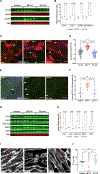Inflammatory Glycoprotein 130 Signaling Links Changes in Microtubules and Junctophilin-2 to Altered Mitochondrial Metabolism and Right Ventricular Contractility
- PMID: 34923829
- PMCID: PMC8766918
- DOI: 10.1161/CIRCHEARTFAILURE.121.008574
Inflammatory Glycoprotein 130 Signaling Links Changes in Microtubules and Junctophilin-2 to Altered Mitochondrial Metabolism and Right Ventricular Contractility
Abstract
Background: Right ventricular dysfunction (RVD) is the leading cause of death in pulmonary arterial hypertension (PAH), but no RV-specific therapy exists. We showed microtubule-mediated junctophilin-2 dysregulation (MT-JPH2 pathway) causes t-tubule disruption and RVD in rodent PAH, but the druggable regulators of this critical pathway are unknown. GP130 (glycoprotein 130) activation induces cardiomyocyte microtubule remodeling in vitro; however, the effects of GP130 signaling on the MT-JPH2 pathway and RVD resulting from PAH are undefined.
Methods: Immunoblots quantified protein abundance, quantitative proteomics defined RV microtubule-interacting proteins (MT-interactome), metabolomics evaluated the RV metabolic signature, and transmission electron microscopy assessed RV cardiomyocyte mitochondrial morphology in control, monocrotaline, and monocrotaline-SC-144 (GP130 antagonist) rats. Echocardiography and pressure-volume loops defined the effects of SC-144 on RV-pulmonary artery coupling in monocrotaline rats (8-16 rats per group). In 73 patients with PAH, the relationship between interleukin-6, a GP130 ligand, and RVD was evaluated.
Results: SC-144 decreased GP130 activation, which normalized MT-JPH2 protein expression and t-tubule structure in the monocrotaline RV. Proteomics analysis revealed SC-144 restored RV MT-interactome regulation. Ingenuity pathway analysis of dysregulated MT-interacting proteins identified a link between microtubules and mitochondrial function. Specifically, SC-144 prevented dysregulation of electron transport chain, Krebs cycle, and the fatty acid oxidation pathway proteins. Metabolomics profiling suggested SC-144 reduced glycolytic dependence, glutaminolysis induction, and enhanced fatty acid metabolism. Transmission electron microscopy and immunoblots indicated increased mitochondrial fission in the monocrotaline RV, which SC-144 mitigated. GP130 antagonism reduced RV hypertrophy and fibrosis and augmented RV-pulmonary artery coupling without altering PAH severity. In patients with PAH, higher interleukin-6 levels were associated with more severe RVD (RV fractional area change 23±12% versus 30±10%, P=0.002).
Conclusions: GP130 antagonism reduces MT-JPH2 dysregulation, corrects metabolic derangements in the RV, and improves RVD in monocrotaline rats.
Keywords: glycoprotein; interleukin-6; monocrotaline; proteomics; pulmonary arterial hypertension.
Figures








Comment in
-
Targeting Inflammation in Pulmonary Artery Hypertension: Is It Time to Forget About the Lungs?Circ Heart Fail. 2022 Jan;15(1):e009290. doi: 10.1161/CIRCHEARTFAILURE.121.009290. Epub 2021 Dec 20. Circ Heart Fail. 2022. PMID: 34923831 Free PMC article. No abstract available.
-
Response by Prisco and Prins to Letter Regarding Article, "Inflammatory Glycoprotein 130 Signaling Links Changes in Microtubules and Junctophilin-2 to Altered Mitochondrial Metabolism and Right Ventricular Contractility".Circ Heart Fail. 2022 Aug;15(8):e009570. doi: 10.1161/CIRCHEARTFAILURE.122.009570. Epub 2022 Jun 27. Circ Heart Fail. 2022. PMID: 35758028 Free PMC article. No abstract available.
-
Letter by Li and Nie Regarding Article, "Inflammatory Glycoprotein 130 Signaling Links Changes in Microtubules and Junctophilin-2 to Altered Mitochondrial Metabolism and Right Ventricular Contractility".Circ Heart Fail. 2022 Aug;15(8):e009531. doi: 10.1161/CIRCHEARTFAILURE.122.009531. Epub 2022 Jun 27. Circ Heart Fail. 2022. PMID: 35758045 No abstract available.
References
-
- Vonk Noordegraaf A, Chin KM, Haddad F, Hassoun PM, Hemnes AR, Hopkins SR, Kawut SM, Langleben D, Lumens J, Naeije R. Pathophysiology of the right ventricle and of the pulmonary circulation in pulmonary hypertension: An update. Eur Respir J. 2019;53:1801900. doi: 10.1183/13993003.01900-2018. - DOI - PMC - PubMed
-
- Xie YP, Chen B, Sanders P, Guo A, Li Y, Zimmerman K, Wang LC, Weiss RM, Grumbach IM, Anderson ME, Song LS. Sildenafil prevents and reverses transverse-tubule remodeling and ca(2+) handling dysfunction in right ventricle failure induced by pulmonary artery hypertension. Hypertension. 2012;59:355–362 - PMC - PubMed
Publication types
MeSH terms
Substances
Grants and funding
LinkOut - more resources
Full Text Sources
Medical

